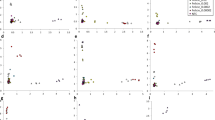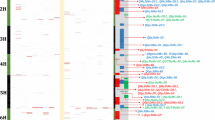Abstract
The deployment of genetic markers is of interest in crop assessment and breeding programmes, due to the potential savings in cost and time afforded. As part of the internationally recognised framework for the awarding of Plant Breeders’ Rights (PBR), new barley variety submissions are evaluated using a suite of morphological traits to ensure they are distinct, uniform and stable (DUS) in comparison to all previous submissions. Increasing knowledge of the genetic control of many of these traits provides the opportunity to assess the potential of deploying diagnostic/perfect genetic markers in place of phenotypic assessment. Here, we identify a suite of 25 genetic markers assaying for 14 DUS traits, and implement them using a single genotyping platform (KASPar). Using a panel of 169 UK barley varieties, we show that phenotypic state at three of these traits can be perfectly predicted by genotype. Predictive values for an additional nine traits ranged from 81 to 99 %. Finally, by comparison of varietal discrimination based on phenotype and genotype resulted in correlation of 0.72, indicating that deployment of molecular markers for varietal discrimination could be feasible in the near future. Due to the flexibility of the genotyping platform used, the genetic markers described here can be used in any number or combination, in-house or by outsourcing, allowing flexible deployment by users. These markers are likely to find application where tracking of specific alleles is required in breeding programmes, or for potential use within national assessment programmes for the awarding of PBRs.


Similar content being viewed by others
References
Arens P, Mansilla C, Deinum D, Cavellini L, Moretti A, Rolland S, van der Schoot H, Calvache D, Ponz F, Collonnier C, Mathis R, Smilde D, Caranta C, Vosman B (2010) Development and evaluation of robust molecular markers linked to disease resistance in tomato for distinctness, uniformity and stability testing. Theor Appl Genet 120:655–664. doi:10.1007/s00122-099-1183-2
Boyd WJR, Li CD, Grime CE, Cakir CR, Potipibol S, Kaveeta L, Men S, Jalal Kamali MR, Barr AR, Moody DB, Lance RCM, Logue SJ, Raman H, Read BJ (2003) Conventional and molecular genetic analyses of factors contributing to the variation in the timing of heading among spring barley (H. vulgare L.) genotypes grown over a mild winter growing season. Aust J Agric Res 54:1277–1301. doi:10.1071/ar03014
Chono M, Honda I, Zeniya H, Yoneyama K, Saisho D, Takeda K, Takatsuto S, Hoshino T, Wantanabe Y (2003) A semidwarf phenotype of barley uzu results from a nucleotide substitution in the gene encoding a putative brassinosteroid receptor. Plant Physiol 133:1209–1219. doi:10.1104/pp103.026195
Close TJ, Bhat PR, Lonardi S, Wu Y, Rostoks N, Ramsay L, Druka A, Stein N, Svensson JT, Wanamaker S et al (2009) Development and implementation of high-throughput SNP genotyping in barley. BMC Genomics 10:e582. doi:10.1186/1471-2164-10-582
Cockram J, Jones H, Leigh FJ, O’Sullivan D, Powell W, Laurie DA, Greenland AJ (2007a) Control of flowering time in temperate cereals: genes, domestication and sustainable productivity. J Exp Bot 58:1231–1244. doi:10.1093/jxb/erm042
Cockram J, Chiapparino E, Taylor SA, Stamati K, Donini P, Laurie DA, O’Sullivan DM (2007b) Haplotype analysis of vernalization loci in European barley germplasm reveals novel VRN-H1 alleles and a predominant winter VRN-H1/VRN-H2 multi-locus haplotype. Theor Appl Genet 115:993–1001. doi:10.1007/s00122-007-0626-x
Cockram J, Mackay IJ, O’Sullivan DM (2007c) The role of double-stranded break repair in the creation of phenotypic diversity at cereal VRN1 loci. Genetics 177:1–5. doi:10.1534/genetics.107.074765
Cockram J, White J, Leigh FJ, Lea VJ, Chiapparino E, Laurie DA, Mackay IJ, Powell W, O’Sullivan DM (2008) Association mapping of partitioning loci in barley (Hordeum vulgare ssp. vulgare L.). BMC Genet 9:e16. doi:10.1186/1471-2156-9-16
Cockram J, Norris C, O’Sullivan DM (2009) PCR markers diagnostic for seasonal growth habit in barley. Crop Sci 49:403–410. doi:10.2135/cropsci2008.07.0398
Cockram J, Howells RM, O’Sullivan DM (2010a) Segmental chromosomal duplications harbouring group IV CONSTANS-like genes in cereals. Genome 53:231–240. doi:10.1139/g09-101
Cockram J, White J, Zuluaga DL, Smith D, Comadran J et al (2010b) Genome-wide association mapping to candidate polymorphism resolution in the un-sequenced barley genome. Proc Natl Acad Sci USA 107:21611–21616. doi:10.1073/pnas.1010179107
Devos KM (2005) Updating the ‘crop circle’. Curr Opin Plant Biol 8:155–162. doi:10.1016/j.pbi.2005.01.005
Dubcovsky J, Chen C, Yan L (2005) Molecular characterization of allelic variation at the VRN-H2 vernalization locus in barley. Mol Breed 15:395–407. doi:10.1007/s11032-005-0084-6
Ellis RP, J Russell, L Ramsay, R Waugh (1999) Barley domestication–Hordeum spontaneum, a source of new genes for crop improvement. Scottish Crop Research Institute report. http://www.scri.ac.uk/scri/file/individualreports/1999/14BARLEY.PDF. Accessed 25 Jan 2012
Faure S, Higgins J, Turner A, Laurie DA (2007) The FLOWERING LOCUS-T-like family in barley (Hordeum vulgare). Genetics 176:599–609. doi:10.1534/genetics.106.069500
Franckowiak JD (1995) Notes on linkage drag in Bowman backcross derived lines of spring barley. Barley Genet Newsl 24:63–70
Gunjaca J, Buhinicek I, Jukic M, Sarcevic H, Vragolovic A, Kozic Z, Jambrovic A, Pejic I (2008) Discriminating maize inbred lines using molecular and DUS data. Euphytica 161:165–172. doi:10.1007/s10681-007-9518-z
Ibáñez J, Vargas AM, Palancar M, Borrego J, de Andrés MT (2009a) Genetic relationships among table-grape varieties. Am J Enol Vitic 60:35–42
Ibáñez J, Vélez MD, de Andrés MT, Borrego J (2009b) Molecular markers for establishing distinctness in vegetatively propagated crops: a case study in grapevine. Theor Appl Genet 119:1213–1222. doi:10.1007/s00122-009-1122-2
Islam AKMR (1983) Ditelosomic additions of barley chromosomes to wheat. In: Sakamoto S (ed) Proceedings of the 6th international wheat symposium. Maruzen Co. Ltd, Koyota, pp 223–238
Jia Q, Zhang J, Wescott S, Zhang XQ, Bellgard M, Lance R, Li C (2009) GA-20 oxidase as a candidate for the semidwarf gene sdw1/denso in barley. Funct Integr Genomics 9:255–262. doi:10.1007/s10142-009-0120-4
Karsai I, Szűcs P, Mészáros K, Filichkina T, Hayes PM, Skinner JS, Láng L, Bedö Z (2005) The Vrn-H2 locus is a major determinant of flowering time in a facultative x winter growth habit barley (Hordeum vulgare L.) mapping population. Theor Appl Genet 110:1458–1466. doi:10.1007/s00122-005-1979-7
Komatsuda T, Mano Y (2002) Molecular mapping of the intermedium spike-c (int-c) and non-brittle rachis 1 (btr1) loci in barley (Hordeum vulgare L.). Theor Appl Genet 105:85–90. doi:10.1007/s00122-001-0858-0
Komatsuda T, Tanno K (2004) Comparative high resolution map of the six-rowed spike locus 1 (vrs1) in several populations of barley, Hordeum vulgare L. Hereditas 141:68–73. doi:0.1111/j.1601-5223.2004.01820.x
Komatsuda T, Pourkheirandish M, He C, Azhaguvel P, Kanamori H, Perovic D, Stein N, Graner A, Wicker T, Tagiri A, Lundqvist U, Fujimura T, Matsuoka M, Matsumoto T, Yano M (2007) Six-rowed barley originated from a mutation in a homeodomain-leucine zipper I-class homeobox gene. Proc Natl Acad Sci USA 104:1424–1429. doi:10.1073/pnas.0608580104
Laurie DA, Pratchett N, Bezant JH, Snape JW (1995) RFLP mapping of five major genes and eight quantitative trait loci controlling flowering time in a winter x spring barley (Hordeum vulgare L.) cross. Genome 38:575–585. doi:10.1139/g95-074
Liu K, Muse SV (2005) PowerMarker: an integrated analysis environment for genetic marker analysis. Bioinformatics 21:2128–2129. doi:10.1093/bioinformatics/bti282
Lundqvist U, Franckowiak J, Konishi T (1996) New and revised descriptions of barley genes. Barley Genet Newsl 26:22–43
Lundqvist U, Franckowiak JD, Konoshi T (1997) New and revised descriptions of barley genes. Barley Genet Newsl 26:22–516
Matzumoto T, Tanaka T, Sakai H, Amano N, Kanamori H, Kurita A, Kamiya K, Yamamoto M, Ikawa H, Fujii N, Hiri K, Itoh T, Sato K (2011) Comprehensive sequence analysis of 24,783 barley full-length cDNAs derived from 12 clone libraries. Plant Physiol 156:20–28. doi:10.1104/pp110.171579
Maughan PJ, Yourstone SM, Byers RL, Smith SM, Udall JA (2010) Single-nucleotide polymorphism genotyping in mapping populations via genomic reduction and next-generation sequencing: proof of concept. Plant Genome 3:166–178. doi:10.3835/plantgenome2010.07.0016
Mayer KFX, Martis M, Hedley PE, Šimokova H, Liu H, Morris JA, Steuernagel B, Taudien S et al (2011) Unlocking the barley genome by chromosomal and comparative genomics. Plant Cell 23:1249–1263. doi:10.1105/tpc.110.082537
Nair SK, Wang N, Turuspekov Y, Pourkheirandish M, Sinsuwongwat S et al (2010) Cleistogamous flowering in barley arises from the suppression of microRNA-guided HvAP2 mRNA cleavage. Proc Natl Acad Sci USA 107:490–495. doi:10.1073/pnas.0909097107
Nielsen R, Paul JS, Albrechtsen A, Song YS (2011) Genotype and SNP calling from next-generation sequencing data. Nat Rev Genet 12:443–451. doi:10.1038/nrg2986
Noli E, Teriaca MS, Sanguineti MC, Conti S (2008) Utilization of SSR and AFLP markers for the assessment of distinctness in durum wheat. Mol Breed 22:301–313. doi:10.1007/s11032-008-9176-4
Ramsay L, Comadran J, Druka A, Marshall DF, Thomas WT, Macaulay M, MacKenzie K, Simpson C, Fuller J, Bonar N, Hayes PM, Lundqvist U, Franckowiak JD, Close TJ, Muehlbauer GJ, Waugh R (2011) INTERMEDIUM-C, a modifier of lateral spikelet fertility in barley, is an ortholog of the maize domestication gene TEOSINTE BRANCHED 1. Nat Genet 43:169–172. doi:10.1038/ng.745
Tan L, Li X, Liu F, Sun X, Li C, Zhu Z, Fu Y, Cai H, Wang W, Xie D, Sun C (2008) Control of a key transition from prostrate to erect growth in rice domestication. Nat Genet 40:1360–1364. doi:10.1038/ng.197
Turner A, Beales J, Faure S, Dunford RP, Laurie DA (2005) The pseudo-response regulator Ppd-H1 provides adaptation to photoperiod in barley. Science 310:1031–1034. doi:10.1126/science.1117619
Von Korff M, Grando S, Del Greco A, This D, Baum M, Ceccarelli S (2008) Quantitative trait loci associated with adaptation in Mediterranean dryland conditions in barley. Theor Appl Genet 117:653–669. doi:10.1007/s00122-008-0787-2
von Zitzewitz J, Szűcs P, Dubcovsky J, Yan L, Francia E, Pecchioni N, Casas A, Chen THH, Hayes P, Skinner J (2005) Molecular and structural characterization of barley vernalization genes. Plant Mol Biol 59:449–467. doi:10.1007/s11103-005-0351-2
Waugh R, Marshall D, Thomas B, Comadran J, Russell J, Close T, Stein N, Hayes P, Muehlbauer G, Cockram J, O’Sullivan D, Mackay I, Flavell A, Agoueb A, Barleycap RL (2010) Whole-genome association mapping in elite inbred crop varieties. Genome 53:967–972. doi:10.1139/G10-078
Yu Y, Tomkins JP, Waugh R, Frisch DA, Kudrna D, Kleinhofs A, Bruggeman RS, Meuhlbauer GJ, Wise RP, Wing RA (2000) A bacterial artificial chromosome library for barley (Hordeum vulgare L.) and the identification of clones containing putative resistance genes. Theor Appl Genet 101:1093–1099. doi:10.1007/s001220051584
Acknowledgments
This work was funded by Defra grant 2009H. We thank the James Hutton Institute for provision of the European barley germplasm.
Author information
Authors and Affiliations
Corresponding authors
Additional information
Communicated by P. Hayes.
Electronic supplementary material
Below is the link to the electronic supplementary material.
Rights and permissions
About this article
Cite this article
Cockram, J., Jones, H., Norris, C. et al. Evaluation of diagnostic molecular markers for DUS phenotypic assessment in the cereal crop, barley (Hordeum vulgare ssp. vulgare L.). Theor Appl Genet 125, 1735–1749 (2012). https://doi.org/10.1007/s00122-012-1950-3
Received:
Accepted:
Published:
Issue Date:
DOI: https://doi.org/10.1007/s00122-012-1950-3




